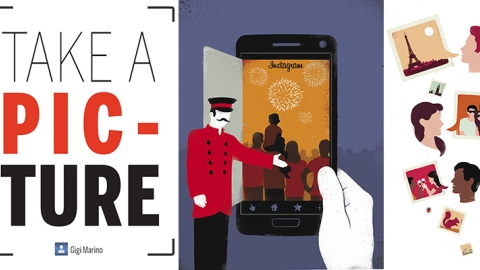
Take a Picture
July 17, 2014
Array: Illustration by Sébastien Thibault
Has the rising popularity of image sharing changed the way we communicate?
Ever since our Paleolithic ancestors started grinding rock and root to create color to paint cave walls with animal images some 35,000 years ago, humankind has relied on visual communication. Though no one can say with certainty the intention of those prehistoric murals, we do know this: The very narrative of our hominid history is wrapped around a series of images, imagined or rendered and the only thing that has changed about this truth over the millennia is the technology we use to capture and share those images.
Now more than ever, not only are images omnipresent in our personal and professional lives, but they also have become a defining characteristic of the younger generation. Bill Carter, a principal partner in Fuse Marketing in Burlington, Vt., has been studying trends in teen and youth culture for more than 15 years. His company routinely tracks the patterns, habits and behaviors of 15- to 29-year-olds.
"The world of young people is based on the image, capturing the image and sharing the image," says Carter. "To 'share' means to share an image or video and the experience is not validated if it is not captured in image or video. Sharing is critical."
Additionally, sharing happens hummingbird fast. Say you are traveling in London or L.A. and you happen upon the Queen of England or Katie Perry. You snap a photo on your phone and within seconds, everyone in your social media network knows you’ve had a run-in with fame. According to a 2013 survey done by the global marketing research company Ipsos, photos are by far the most popular shared content on the internet, with four in 10 users (43 percent) saying they shared a photo in the past month.
Long gone and never to return are the days when you would drop off a roll of film at the drug store, come back a week later to pick up the prints and then share them with family and friends. Young people don’t even know what this means, says Carter. "They didn’t adopt the technology. They were born into it," he says. "The young person learns to meet new people, manage friendships, communicate effectively among peers and end relationships both online and offline. Previous generations were doing all of these things offline."
So while it may be baffling for a 50- or 60-year-old to understand the meteoric rise of mobile photo sharing apps such as Instagram and Snapchat, for a 20-something, visual communication is second nature — and on the rise. New figures from Pew show that Instagram is the fastest growing form of social media. Snapchat, according to the website Digital Marketing Ramblings (DMR), has 26 million users sending 400 million Snapchats per day.
"Forget email. Forget texting. Students use Snapchat to coordinate when to meet their friends at Bostwick for lunch," says Heather Johns, Bucknell’s web and social media editor. "Today’s students are highly visual, which is why we’ve adapted our communication strategies to connect and share information with them."
One example is the Bucknell Study Abroad Instagrammer project, which replaced student bloggers highlighting their learning experiences around the world. "It’s much more natural for students to chronicle their adventures abroad with a photo and brief caption," says Johns. "It’s also easier for people to follow along and engage with the students by liking or commenting — right from their smartphones."
Recent graduate Sonali Basak ’12 says she depends on social media to keep her in touch with classmates, friends and her family in India. "We all connect from miles away," she says. "A photo can be really poignant and makes communication a lot more personal. It’s also faster. Lots of times I will send a photo rather than text. There’s something visceral about sight that tells you more. An image evokes an emotion much differently than words can."
Even so, Basak, who works as a reporter for Bloomberg News, says that the image does not trump the written word. "Pictures tell a story but they don’t tell the whole story. People want a deeper insight," she says. "I think that people are reading more. The words tell you more. That’s why I chose to be a writer."
Author Stephen Apkon agrees. In his book, The Age of the Image — Redefining Literacy in a World of Screens, he presents the idea that though the image is more ubiquitous and powerful now than ever, it does not diminish literacy, but actually strengthens it. He writes, "There will never be a 'death' of words on paper (or on screens), or an end to the sequentially ordered sentences that define how we transmit and preserve ideas. That form of expression will never cease to be relevant … The literacy of images shares a mutually reinforcing relationship with the literacy of words. The two are forever entangled."
In the late 1960s, John Debes of Eastman Kodak coined the term “visual literacy,” which refers to the human ability to interpret and interpolate visual data with other sensory information. Basically, Debes said, the eyes see and the brain makes sense of it all. Apkon latches onto this notion and runs with it. “The time has come to rebuild the idea of ‘visual literacy’ — not to overthrow it, but to expand it,” he writes. “We must now take into account what is technologically inevitable in the 21st century: the proliferation of images that are increasingly married to the wordless visual pathways of knowledge that have been the human birthright since before we were even humans.”
Mobile-app programmers understand this phenomenon well. In addition to Instagram (which, according to DMR, has 200 million active users a month) and Snapchat are dozens of other apps promoting the image: Facebook, Pinterest, Tango and video sites such as YouTube and Vine.
Facebook is, by far, the reigning queen of the social-media ball with nearly 1.3 billion users — and the most popular content shared on the site? Photos. According to Facebook, 1 million links are shared every 20 minutes. Recognizing the popularity of image sharing, Facebook bought Instagram for $1 billion and tried to buy Snapchat for $3 billion.
Basak, who maintains a Facebook page for her own writing and reporting, says, "I try not to post a story that doesn’t have a photo because more people click on stories with photos." Additionally, she says, "There is rightfully a lot of attention on the photo medium, with several companies trying to develop the next best photo app. It’s just the thing that makes sense right now."
This publication, Bucknell Magazine, itself underwent a major redesign in 2008, moving from a two-color tabloid to a four-color glossy publication. Over the years, a number of readers have written in to say how much better the writing is. Interestingly, the magazine employs many of the writers it did in the tabloid years. But what has changed is the editorial decision to use an image or graphic element for every story. The writing is just as good as it was a decade ago; we just use more photos and artwork.
Back at Fuse Marketing, Carter attributes the image’s omnipresence to the increasing number of photo-capable cell phones sold since 2006. Prior to that year, he says, the usage was less than 50 percent. Today, he says, that number is in the high 80 to low 90 percentile range.
"If you were taking images of you and your friends in 2006, you were taking the images and looking at them with your friends," he says. "Now, you’re taking the image for the purpose of posting on social media, which has grown to the point that all of your friends are on Facebook or Twitter or, with teens, on Snapchat. That’s your delivery mechanism — a phenomenon that’s less than 10 years old."
Back in the way back, the 20th century, in the days of the Jets and the Sharks, a popular retort to rude teen behavior was, "Take a picture. It will last longer." In the irony that is the 21st century, this is both true and not true. Pictures are indeed more prolific, but even so, more ephemeral. Five minutes on Facebook and your 15 minutes of fame is gone.
The image tantalizes. But the written word will never leave us. The most attributed person of any century? William Shakespeare — a writer who painted fantastic pictures with his words that forever changed the language of human history.
"Such as we are made of, such we be."
"Call me" evokes so much more.
Imagine that. And we do.

